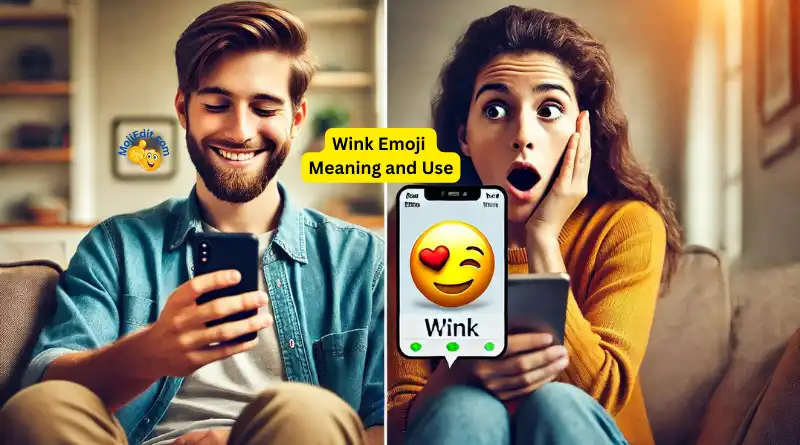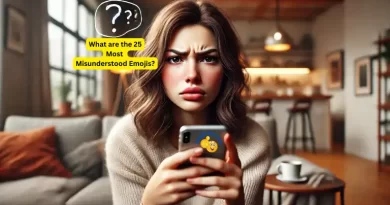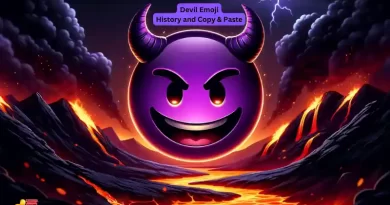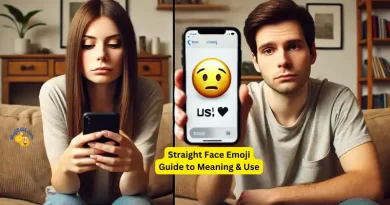What Does The Wink Emoji Mean? Unraveling Emoticon Mysteries
What does the wink emoji mean? It’s a question that has puzzled many in the digital age.
The wink emoji, an icon of mystery and intrigue, pops up everywhere from friendly chats to flirty texts.
But what does it really signify? Is it a sign of flirtation or just playful banter?
In this post, we’ll unravel the enigma behind what does the wink emoji mean, exploring its various interpretations across different contexts and generations.
Table of Contents:
- The World of Emojis
- Decoding the Wink Emoji
- Generational Differences in Emoji Interpretation
- The Science Behind Emoji Interpretation
- Other Emojis with Multiple Meanings
- Using Emojis Effectively Across Generations
- FAQs in Relation to Wink Emoji Meanings
- Conclusion
The World of Emojis
Emojis have revolutionized the way we communicate in this digital age.
With over 3,633 officially recognized emojis, they are a universal language that transcends cultural and linguistic barriers.
A staggering ten billion emojis are sent each day across various messaging platforms like Slack, signifying their immense popularity.
Rise of Emoji Communication
In an era where text-based emoticons were once king, emojis offer a vibrant and expressive alternative to convey emotion.
This colorful form of communication ranges from smiling faces to more confusing depictions such as nail varnish or even the wi-fi symbol.
An Emotional Bridge in Digital Conversations
Digital conversations can often seem cold and impersonal due to lack of non-verbal cues.
To fill this gap, popular emoji symbols like winking face emoji or shaking face come into play.
Serving as visual aids for emotions ranging from joyous laughter to sarcasm, these small pictographs add warmth and authenticity to our online interactions.
Beyond Text: The Visual Appeal Of Emojis
No longer just replacements for words or phrases, ‘Elon Musk’s poop emoji reply’ is proof enough how well-placed use could lead harmless ‘I’m kidding’ messages becoming viral overnight.
It’s not only about what you say but also how visually appealing your message appears on screen.
This section has explored the rise significance emojis within modern-day communications providing insight into why they’ve become so prevalent today’s society. In next part article will delve deeper understanding meaning behind one most commonly used icons- wink . Stay tuned learn more about its hidden meanings potential awkward interpretations based context usage.
Decoding the Wink Emoji
The winking face emoji, a popular emoji on various messaging platforms like Slack and WhatsApp, is often used to replace text-based emoticons. But what does it really mean?
A Versatile Symbol in Digital Communication
In essence, the wink emoji signifies a playful or jokey mood.
It can be seen as an electronic version of someone giving you a cheeky wink across the room – suggesting they’re either joking around or perhaps even flirting with you over text.
This makes it quite versatile for communicating emotion in digital conversations.
The Hidden Meaning Behind The Wink Emoji
Sometimes though, this seemingly harmless ‘I’m kidding’ message might have other interpretations that are not immediately obvious.
For instance, if your crush sends you a winking face after making fun of something you did earlier – there could be some sexual connotations involved too.
This particular interpretation varies significantly depending upon individual perception and context.
The Wink Emoji from Your Crush: Flirtation Or Friendly Banter?
If your crush uses the winking face frequently during conversation with you – don’t get confused just yet. It’s crucial to consider all aspects before jumping into conclusions about their intentions.
Possibly they may simply intend to keep things light-hearted without any hidden meaning behind those emojis. We recommend paying attention to how these emojis fit within overall dialogue patterns between both parties.
Beyond Just A Simple Gesture: What Does This Mean For You?
To put it simply; If these flirtatious exchanges make sense given prior interactions & existing relationship dynamics then yes.
You might want take note of this potentially significant signal indicating romantic interest towards yourself.
If however such usage appears out-of-place considering general tone throughout past communications; chances are high that person probably doesn’t harbor secret feelings beyond friendship level at least currently anyway.
Key Takeaway:
The winking face emoji, a popular symbol in digital communication, can have various meanings. It is often used to convey playfulness or joking around, and it can also be seen as flirtatious. However, the interpretation of this emoji depends on individual perception and context. If your crush frequently uses the wink emoji during conversations with you, it could indicate romantic interest or simply friendly banter. Pay attention to overall dialogue patterns to understand their intentions better.
Wink Emoji 😉Text Examples
Understanding how to use the wink emoji in different contexts can make your messages more fun and expressive. Here are some examples of how to use the wink emoji in various types of messages:
Friendly Chat
Text: “Hey, don’t forget to bring the snacks tonight 😉” Meaning: A playful reminder with a hint of friendly teasing. Perfect for keeping the conversation light and fun!
Flirty Message
Text: “I had a great time with you today. Maybe we should do it again sometime soon? 😉” Meaning: A subtle hint of interest, making the message feel more personal and flirty. Great for letting someone know you enjoyed their company!
Sarcasm
Text: “Oh sure, because I definitely wanted to clean the entire house by myself 😉” Meaning: The wink emoji here indicates that the statement is sarcastic. It adds a playful tone to your sarcasm, making sure it’s taken lightly.
Inside Joke
Text: “Remember that time we got lost on our way to the concert? Good times 😉” Meaning: Using the wink emoji to recall a funny or memorable moment shared with someone. It brings back shared memories in a fun way!
Emoji Combos with the Wink Emoji 😜😉
Combining the wink emoji with other emojis can enhance your message and convey more nuanced emotions. Here are some fun combinations:
Wink + Heart ❤️
Combo: 😉❤️ Use: To add a flirty or affectionate tone to your message with the red heart emoji. Example: “You always know how to make me smile 😉❤️”
Wink + Thumbs Up 👍
Combo: 😉👍 Use: To show playful approval or agreement. Example: “Great job on the presentation today 😉👍”
Wink + Laughing Face 😂
Combo: 😉😂 Use: To indicate that you’re joking or being playful. Example: “I’m totally going to win this game 😉😂”
Wink + Coffee Cup ☕
Combo: 😉☕ Use: To suggest a casual meet-up or coffee date with the coffee emoji. Example: “Let’s catch up over coffee this weekend 😉☕”
Related Emojis 😊😏
Several other emojis can be used in a similar context or alongside the wink emoji to enhance your messages:
Smirking Face Emoji 😏
The smirking face emoji is often used to convey a sly or smug expression. It can be used in flirty or teasing contexts. Example: “You think you can beat me at this game? Think again 😏”
Grinning Face with Sweat Emoji 😅
This emoji can be used to indicate nervousness or relief, often in a playful way. Example: “That was a close call, but we made it through 😅”
Face with Stuck-Out Tongue and Winking Eye Emoji 😜
This emoji is perfect for playful and silly messages, adding a fun and carefree vibe. Example: “Can’t believe you ate the last slice of pizza 😜”
Face Blowing a Kiss Emoji 😘
Use this emoji to send a kiss or show affection, often used in romantic or friendly contexts. Example: “Goodnight! Sweet dreams 😘”
How do you use the wink emoji in your texts? Share your favorite combinations or fun stories in the comments below! Let’s make our messages more expressive and fun together!
By incorporating these examples, combinations, and related emojis into your texts, you can add more personality and emotion to your digital conversations. Have fun experimenting with different ways to use the wink emoji and its companions!
Generational Differences in Emoji Interpretation
Digital communication, particularly through emojis, can be a tricky terrain to navigate due to generational differences.
A survey conducted by the popular messaging platform Slack revealed intriguing insights into how different generations interpret emojis.
Misunderstandings due to Generational Gap
The winking face emoji or even Elon Musk’s poop emoji reply might seem straightforward for some but could lead others down a path of confusion and misinterpretations.
For instance, one such confusing emoji is the peach symbol. This seemingly harmless fruit has been interpreted as signifying buttocks by younger users while baby-boomers simply see it as just another piece of produce.
The survey, shows that these disparities are not limited only to suggestive symbols.
- The skull emoji which signifies ‘death’ for older people may mean something hilarious (or “dead funny”) among Gen Zs and millennials.
- An innocent nail varnish emoticon is often misunderstood as an indicator of someone being nonchalant or unbothered about an issue when used out-of-context – quite far from its literal meaning.
Even though they’re meant to replace text-based emoticons and make digital conversations more expressive and fun, without proper context or understanding across age groups – misunderstandings are bound.
So next time you use your favorite winking face icon hoping it conveys a jokey mood remember there’s always room for interpretation.
Stay tuned with us as we dive deeper into this fascinating world where smiling faces aren’t always happy ones.
The Science Behind Emoji Interpretation
Emojis have become a universal language, transcending borders and cultures. But how does our brain process these tiny symbols? Let’s delve into the science behind emoji interpretation.
Brain Activity Triggered by Emojis
A fascinating study conducted by researchers revealed that emojis trigger similar brain activity as actual face-to-face communication.
In particular, sentences ending with a winking emoji sparked an intriguing pattern of electrical activity in the participants’ brains.
This response was akin to sarcastic intonation when speaking aloud – suggesting that our brains perceive sarcasm through emojis much like they do from verbal cues.
Winking Face: The Universal Symbol for Sarcasm?
The winking face emoji is often used to convey irony or humor in digital conversations. It’s seen as a harmless ‘I’m kidding’ message which can replace text-based emoticons effectively without causing confusion among recipients.
If you’re interested in diving deeper into this topic, check out this research article on the Cognitive Neuroscience Society’s website here.
Other Emojis with Multiple Meanings
The world of emojis offers a plethora of symbols, each carrying its own hidden meaning.
Apart from the winking face emoji, there are several other popular emojis that can lead to confusing interpretations depending on age groups, cultures or contexts.
Smiling Face Emoji – Happiness or Exasperation?
This simple smiling face is one such example.
To those over 40s it might signify happiness and joy in their messaging platform Slack conversation.
However, Gen Z often uses this emoji when they’re deep in exasperation.
Skull Emoji – Dead Funny or Death?
The skull emoji interpretation also varies significantly across generations.
On the contrary, older users perceive this as an actual symbol of death.
Nail Varnish & Aubergine Emojis: Innocent Symbols Or Not?
The nail varnish and aubergine emojis have stirred up some interesting debates too.
While many see these as harmless everyday items signifying self-care (nail polish) and food (aubergine), others attribute sexual connotations to them based on certain internet memes.
Understanding these nuances becomes crucial while using such ambiguous icons like peach which signifies buttocks among younger folks but just fruit for baby boomers.
As we delve deeper into how different people interpret different emojis differently due to generational gaps next time you send out what seems like a harmless ‘I’m kidding message’, remember not everyone may get your joke.
Using Emojis Effectively Across Generations
The myriad of emojis provide a distinct method for expressing sentiments digitally.
However, the interpretation of these symbols can vary across generations leading to potential miscommunications.
Choosing Universal Emojis
To navigate this challenge effectively, one strategy could be choosing universal emojis. For instance, Emojipedia provides an extensive list that includes popular emoji such as the smiling face or thumbs up which are generally understood similarly across different age groups.
This approach reduces chances of awkward interpretations while still allowing you to replace text-based emoticons with more expressive options.
Being Mindful of Context
In addition to selecting universally accepted icons, it’s crucial being mindful about context when using certain ambiguous emojis like wink or peach emoji.
A harmless ‘I’m kidding’ message might come off differently if not delivered appropriately within a conversation’s context. Psychology Today’s article on “The Secret Language Of Emojis” offers interesting insights into how contextual cues influence our understanding and use of these pictograms.
Beyond just avoiding sexually suggestive emoji due its varying interpretations among people from diverse backgrounds; considering who your recipient is – their cultural background, age group etc., plays a significant role in ensuring effective communication through messaging platform Slack or any other digital medium.
In conclusion: While Elon Musk’s poop emoji reply may seem funny amongst friends, it could potentially cause confusion at work place where someone might interpret it literally instead seeing humor behind it.
Conclusion
We have begun an intriguing exploration into the realm of emojis. We’ve discovered that there are over 3,633 officially recognized ones out there and an estimated ten billion sent each day.
We’ve delved into the intriguing nuances of one in particular – yes, you guessed it right – What Does The Wink Emoji Mean?
From flirtation to sarcasm or just friendly banter, its interpretation can vary greatly based on context and individual perception.
We also discussed how generational differences can lead to varying interpretations and sometimes even misunderstandings when it comes to emoji usage.
The science behind our brain’s reaction to these digital symbols was another captivating discovery. Who knew sentences ending with a winking emoji could trigger similar brain activity as sarcastic intonation in words?
Apart from our star emoticon – the wink emoji – we explored other ambiguous ones like the smiling face or skull emoji whose meanings often get lost in translation across generations or cultures.
To wrap up this enlightening expedition into emojis’ universe, remember that using them effectively is key. Choose universal ones whenever possible and always be mindful of your audience’s age group while using certain ambiguous emojis like our friend Mr. Winky here!
Wink Emoji FAQ
he wink emoji typically signifies a playful or joking mood. It can also indicate flirtation or a shared secret depending on the context of the conversation and the relationship between the sender and the receiver.
No, the wink emoji is not always flirtatious. It can also be used to convey sarcasm, humor, or a light-hearted tone in a message. Context is key to understanding its intended meaning.
You can mirror the wink emoji to reciprocate the playful tone, use a combination of flirty emojis if the context is romantic, or simply acknowledge it with a playful or humorous response. It all depends on your relationship with the sender.
A wink emoji from a girl could indicate flirtation, playfulness, or a shared joke. However, it’s not a definitive sign of romantic interest. It’s best to consider the context and her typical communication style.
A wink emoji from a guy can suggest flirtation, joking, or a light-hearted comment. Like with any emoji, the context and your relationship with him will provide more clarity on his intentions.







